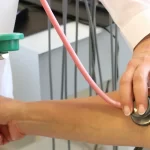Multiple Sclerosis (MS) and headaches are closely linked because MS is a disease associated with nerve damage. Headaches can occur due to MS lesions in the brain or these can also be a side effect of certain medications used to treat multiple sclerosis.
In this article, we will discuss the types of headaches that can occur with multiple sclerosis and their management.
What is Multiple Sclerosis?
Multiple Sclerosis (MS) is a chronic autoimmune demyelinating neurological disease that affects the central nervous system.
People with MS can have symptoms such as weakness, numbness, difficulty with balance and coordination, and loss of vision. Headaches are commonly associated with MS and may be the first symptoms of MS, often overlooked at this stage.
Studies have shown that up to 58% of MS patients experience headaches, compared to around 45% of the general population. These headaches can occur at any time during the disease and can vary in severity and duration.
When a headache occurs during the early stages of MS, it is often overlooked and treated as either tension headache, migraine, or cluster headache.
| You may also like to read: |
Types of Headaches with MS
Different types of headaches can occur in MS patients, including migraines, tension headaches, and cluster headaches. These headaches can have different causes and symptoms and may require different treatments.
Migraine Headaches
Migraine headaches are the most common type of headache experienced by MS patients. They are usually unilateral and pulsating and may be accompanied by visual disturbances and sensitivity to light and sound.
Migraines can be triggered by various factors such as stress, hormonal changes, and certain foods.
Migraine headaches usually last for more than an hour and sometimes may persist for days. It has no association with the timings of the day and can occur at any time of the day.
Tension Headaches
Tension headaches are another type of headache that can occur in MS patients. They are usually bilateral and can feel like a band squeezing around the head.
They are often related to stress and anxiety. People are usually better when they get up early in the morning. As the day passes, the headache worsens in severity and is often more severe at night. It gets better with rest and over-the-counter analgesics.
Cluster Headaches
Cluster headaches are less common but can be very severe. They are usually unilateral and are often described as a burning or piercing pain.
They are typically accompanied by autonomic symptoms such as redness and tearing of the eye, nasal congestion, and sweating.
In addition to these types of headaches, MS patients may also experience headaches related to the disease. For example, headaches may be an early symptom of an MS flare-up or may occur due to nerve damage or other complications.
Other rare forms of headaches associated with MS include:
Ice Pick Headache:
It is an abrupt onset of shooting pain that is felt as if someone has stabbed you in the head or the eyes. The pain is very severe but it lasts for only a few seconds and then goes away.
One similar type of headache also called the Lhermitte sign or Barbar chair sign occurs when a person with MS extends his/her neck to the back just like sitting for a haircut on a barber chair.
It can be treated with medications used to treat migraine headaches including triptans, NSAIDs like indomethacin, and Nurtec.
Behind the eye headache:
Although this is not a different type of headache, but sometimes people with MS or migraine do not have symptoms other than “behind the eye pain“.
This can also be one of the features of impending vision loss as occurs in MS patients with optic neuritis. When it comes and goes, or is associated with other symptoms like changing blood pressure readings, sweating, and palpitations, it may be indicating a migraine headache.
Headache after lumbar puncture:
Often patients with MS undergo CSF drainage for the diagnosis of their condition. CSF is drawn by performing a lumbar puncture procedure.
After the procedure, patients usually develop a headache which is worse on standing or sitting. Post-lumbar puncture headache gets better with adequate hydration, lying recumbent for a few hours after the procedure, and using over-the-counter analgesics.
Headache associated with muscle stiffness in MS patients:
One of the symptoms of MS is muscle stiffness. Muscle stiffness is usually accompanied by headaches. Such headaches are usually more on one side of the body that is affected by MS.
People with headaches due to muscle stiffness can get maximum relief with muscle relaxants and especially Botox injections.
Depression associated headache in MS patients:
Depression is a common manifestation of MS. Most patients have somatic symptoms such as numbness, tingling, fatigue, lethargy, and headache.
Headache is a common symptom of MS-associated depression. Such patients may get relief by taking SSRIs like Fluoxetine or Paroxetine. SNRIs (Duloxetine and Venlafaxine) may also relieve headaches and associated pains but people may develop insomnia especially when it is taken at night.
| You may also like to read: |
Treatment of Headache with MS
To manage headaches in MS patients, it is important to identify any triggers and address them as appropriate.
This may involve lifestyle modifications such as stress reduction techniques, avoiding certain foods or activities, and regular exercise.
Medications such as analgesics, triptans, Nurtec, Ubrelvy, and prophylactic medications may also be used to manage headaches.
Botox is exceptional in relieving headaches in MS patients that are associated with body stiffness and rigidity.
Corticosteroids are wonder drugs for headaches associated with MS that may not only improve the physical symptoms but also help in treating the autoimmune inflammatory plaques in the brain.
Different types of headaches that can occur in MS patients, along with their symptoms and treatments:
| Type of Headache | Characteristics | Treatment |
| Migraine | Unilateral, throbbing/pulsating, with or without aura, lasting 5-30 min, can cause fatigue | Nasal/subcutaneous -triptans for acute relief, beta-blockers for prophylaxis, avoid topiramate in women of childbearing age |
| Cluster Headache | Unilateral, severe pain with autonomic disturbances (excessive salivation and lacrimation), can last up to 3 hours | Sumatriptan and high-flow oxygen for acute relief, indomethacin for termination, steroids, and verapamil for prophylaxis |
| Tension Headache | Associated with stress, bilateral, mild to moderate pain | Cognitive behavioral therapy, SSRIs, NSAIDs, -triptans as per indication, acupuncture, GABAnergic drugs, healthy lifestyle modifications, exercise, active social life with family and friends |
| You may also like to read: |
Conclusion
In conclusion, headaches are a common symptom of MS that can significantly impact a patient’s quality of life.
By identifying triggers and implementing appropriate treatments, patients can better manage these headaches and improve their overall well-being.
Patients need to work closely with their healthcare providers to develop an individualized plan for managing their headaches.



